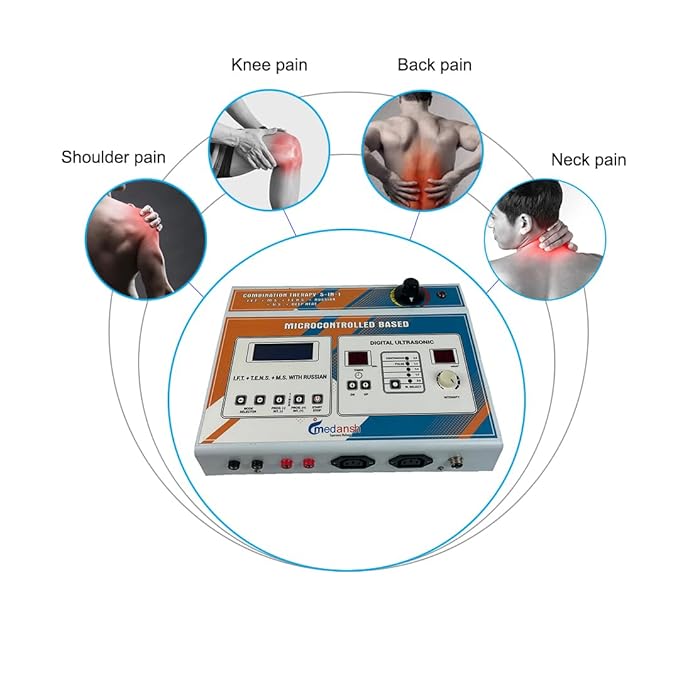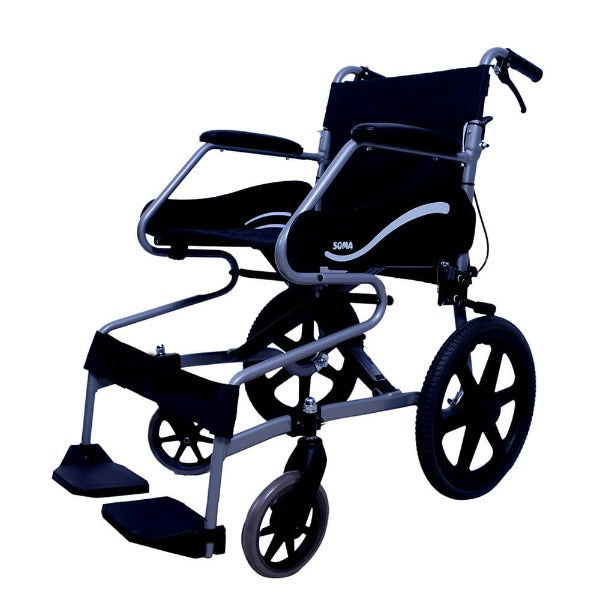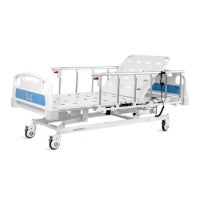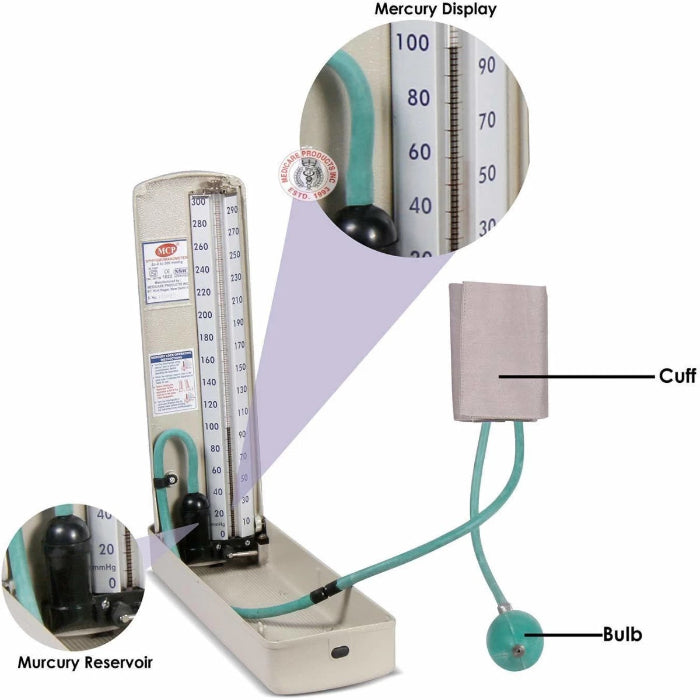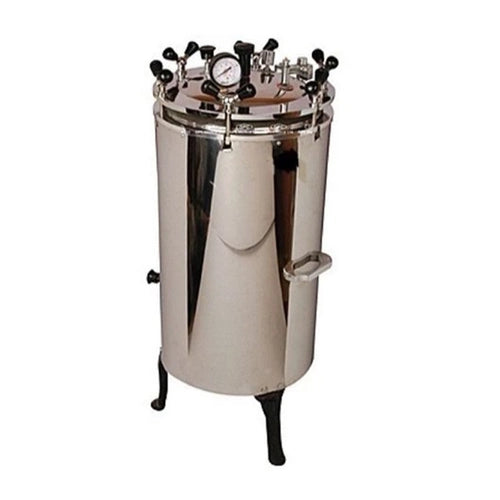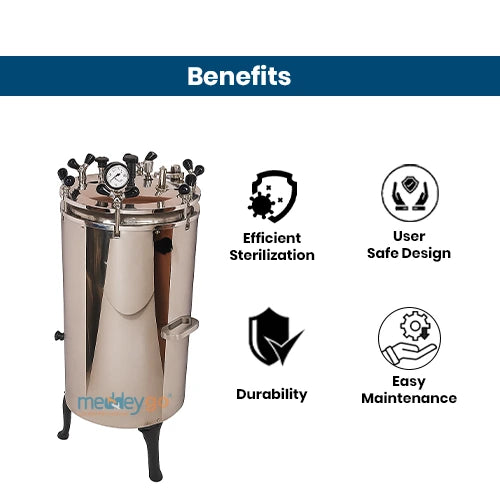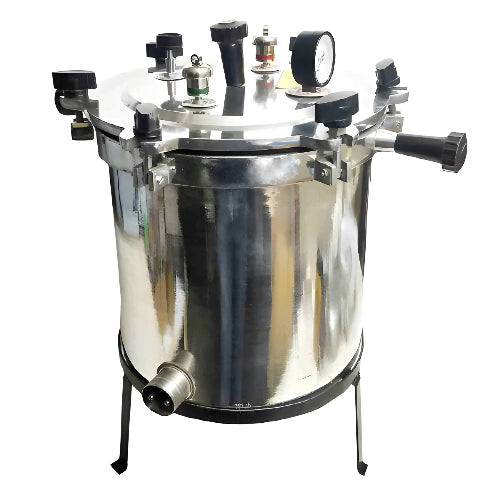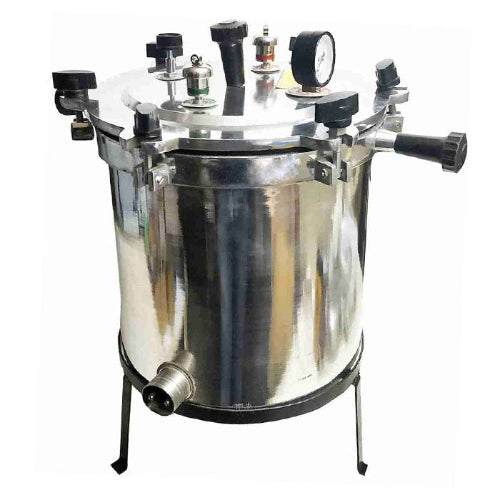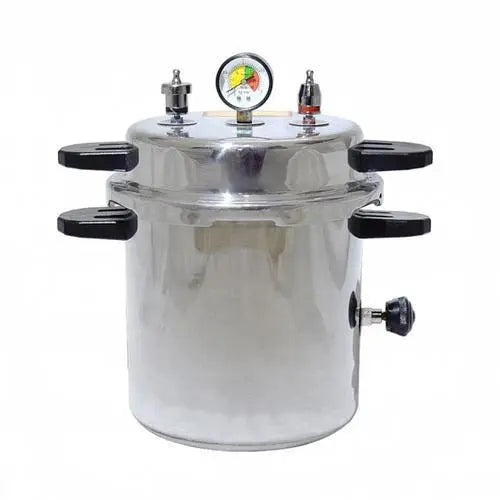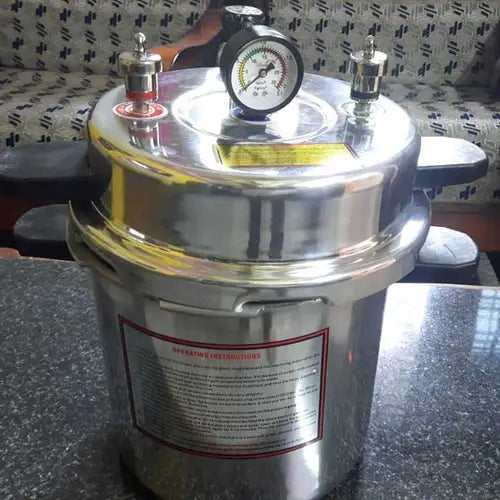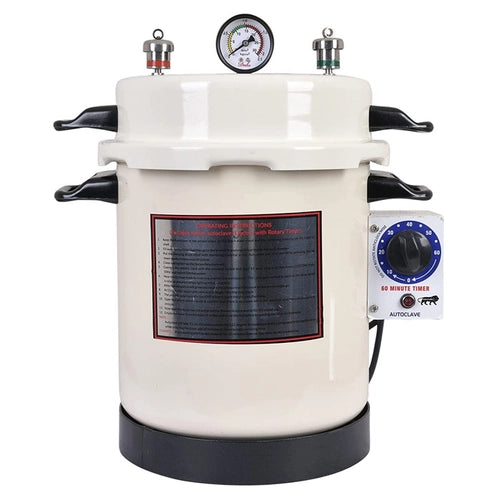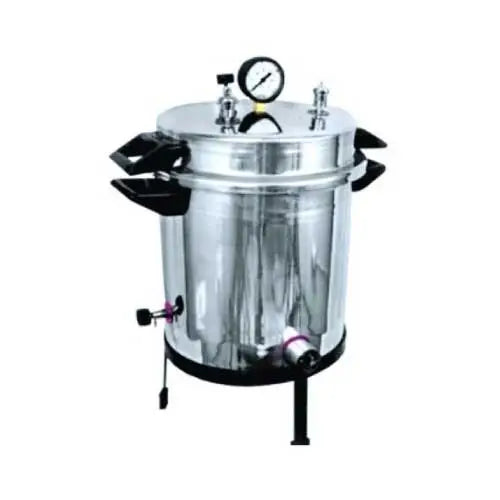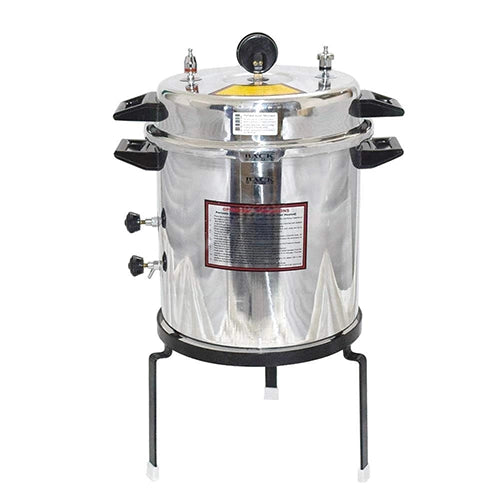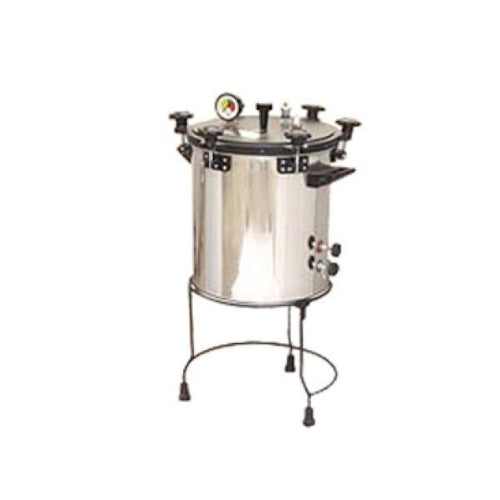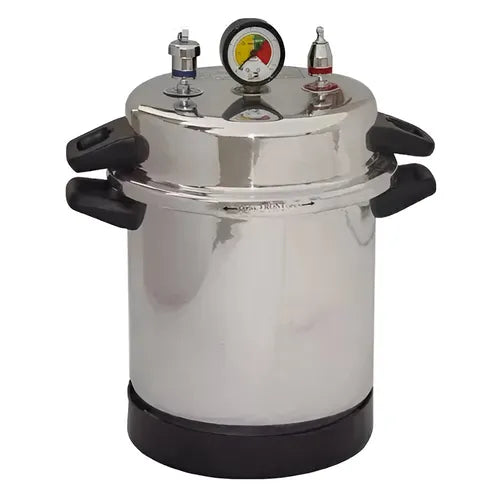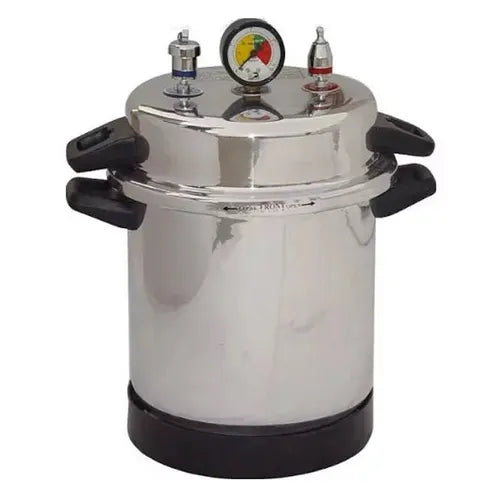Filter
11 products
Type: Autoclave
Vertical Autoclave Machine Wing Nut Type 12 x 22 Inch 40L
Type: Autoclave
Medical Autoclave 21L Wing Nut Aluminium 12 x 12 Inch
Type: General
Autoclave Sterilizer, Mirror Finish, Electric, 10 Liter
Type: Dental Autoclave 10L Cooker
Dental Autoclave 10L Cooker Type with Timer Powder Coated 9 x 11 Inch
Type: General
Autoclave Aluminium Pressure cooker type Electric
Type: General
Autoclave 40 Litres Pressure Cooker Type, Mirror Finish
Type:
Vertical Autoclave Double Wall Radial Locking
Type: autoclave
Vertical Autoclave Double Wall Radial Locking
Type: Autoclave
Vertical Autoclave 80L Double Walled Heavy Duty SS with Digital Tempurature Timer Alram 16x27 Inch
Type: General Accessories
Non-Electric Autoclave sterilizer Wing Nut Type Seamless Aluminium
Type: Dental Autoclave 10L Cooker
Dental Autoclave 10L Cooker Type Aluminium 9 x 11 Inch
Collection:
Autoclave
An autoclave is the main sterilization tool in any serious medical or lab setup. Moreover, an autoclave sterilizer uses high-pressure steam to kill bacteria, viruses, fungi, and even strong spores on instruments, dressings, glassware, and media. On MeddeyGo, this collection brings together practical autoclave machine models for hospitals, clinics, dental practices, and labs that need safe results every day. In addition, within the vertical autoclave range, you will see compact cooker-type units, mid-size autoclave sterilizer options for daily OPD work, and heavy-duty vertical autoclave designs for larger loads. Furthermore, many units work as both a medical and a laboratory autoclave, so one purchase can serve more than one room when you plan loads well. As a result, clear specifications, simple pricing, and GST-ready bills make it easy to choose the right autoclave for your daily work and budget.
Product Overview
An autoclave is a closed vessel that uses hot steam under pressure to sterilize heat-safe items. Additionally, when the steam reaches common set points like 121°C or 134°C and stays there for the right time, it can reliably kill germs and spores on clean instruments and lab ware. Consequently, a properly used autoclave sterilizer becomes a core safety device in any setup.
On this MeddeyGo collection page, the range is built around what Indian buyers actually need. Therefore, you will find:
- Portable and cooker-type autoclave machine options for clinics and small OTs.
- Dental autoclave units around 10L for chairside kits and hand tools.
- Medium and heavy-duty vertical autoclave units for hospitals and teaching centres.
- A non-electric autoclave sterilizer that works on an external flame where power supply is weak or not stable.
Key Features & Benefits
Core Features You’ll Commonly See on This Page
Strong chamber construction
To begin with, most models use an aluminium or stainless steel body that can handle repeated heating and cooling. Moreover, many designs have smooth, mirror-finish inner surfaces in select autoclave machine models for easier cleaning and checking. Consequently, routine maintenance becomes simpler and faster.laboratory autoclave.
Right-sized capacities
In terms of size, about 10–21 L cooker-type autoclave sterilizer units work well for dressings, dental kits, and small trays. Additionally, 40 L pressure cooker-type models suit bigger clinics and nursing homes. Furthermore, 40–80 L vertical autoclave units are ideal for hospitals and labs with higher daily loads. Therefore, you can pick a chamber size that follows your actual workload instead of guessing.
Safe locking and pressure management
From a safety view, wing-nut lids or radial locking rings stay secure when the unit is under pressure. Moreover, a pressure gauge allows quick checks, and safety valves help avoid extra pressure. As a result, staff can use the autoclave machine with more confidence every day.
Electric and non-electric choices
For power options, electric autoclave machine models come with heaters and thermostats for easy plug-and-use operation. Alternatively, non-electric autoclave sterilizer designs sit on a gas stove for field work or backup use. Consequently, both urban and low-power centres can find a suitable solution.
Benefits for Hospitals, Clinics, and Labs
Safer care and cleaner experiments
A correctly used autoclave lowers the chance of cross-infection and supports safe sample handling in labs. Moreover, it helps infection control teams follow clear, documented protocols.
Faster instrument turnaround
When you move from basic chemical disinfection to a dedicated autoclave machine, your process becomes clearer, faster, and less labour-heavy. As a result, instruments return to OT, OPD, and labs more quickly.
Better value over time
A solid autoclave sterilizer with simple controls usually lasts longer than makeshift solutions, especially when you run it many times a day. Consequently, the long-term cost per cycle becomes lower.
One platform for many needs
With several vertical autoclave and cooker-type models on one page, it is easy to set up matching units for OT, dental rooms, wards, and labs. Additionally, this single-source approach simplifies training, stocking, and future replacement.
Technical Specifications
| Type of autoclave | Example capacity range | Construction / style | Heating mode | Typical use case |
|---|---|---|---|---|
| Dental autoclave cooker | 10 L | Compact top-load, powder-coated or aluminium | Electric, often with timer | Dental or ENT chairside loads |
| Heavy-duty vertical 80L | 80 L | Double-wall SS, digital temp + alarm | Electric, higher wattage | CSSD-type loads, larger glassware batches, research labs |
| Non-electric autoclave | 10–20 L | Seamless aluminium, wing-nut lid | External heat source | Backup sterilization, outreach, low-power facilities |
Applications / Use Cases
Hospitals and Nursing Homes
In a hospital, one well-planned vertical autoclave can support several areas at once. For example, it can serve:
- Minor OT and dressing rooms.
- Ward and ICU procedure trolleys.
- Central sterile areas in smaller facilities.
When teams schedule cycles through the day, the same autoclave machine can handle trays, bowls, and basic textile packs. Furthermore, for larger centres, an 80L double-wall unit with digital control gives a more CSSD-style setup that is easier to keep consistent and to audit.
Dental and ENT Practices
For dental and ENT clinics, strong chairside sterilization is essential. Therefore, a 10L cooker-type autoclave sterilizer with a timer offers:
- Quick turnover of handpieces that can tolerate steam.
- Safe processing of mirrors, probes, and small retractors.
- A clear routine that staff can learn fast.
Because these clinics often have very limited space, a compact bench-top autoclave machine is usually the best choice. As a result, you get reliable sterilization without losing valuable floor area.
Diagnostic and Research Labs
In labs, steam sterilization does two key jobs: it prepares sterile media and glassware, and it treats waste before final disposal where rules allow. Consequently, a mid-size laboratory autoclave from this collection can laboratory autoclave:
- Sterilize culture media in flasks and bottles.
- Handle glassware such as test tubes, pipette jars, and beakers.
- Treat microbiology waste so it is safer to handle and discard.
Moreover, a top-load vertical autoclave is usually enough for teaching labs and diagnostic centres that do not yet need a large horizontal unit.
Physiotherapy, Day-Care, and Specialty Clinics
Physiotherapy centres, day-care theatres, and specialty clinics also need steady sterilization for daily tools. For instance, they must process:
- Metal applicators and tools that can handle heat and moisture.
- Dressing sets for small procedures.
- Stainless steel cups and basic surgical instruments.
In these setups, a 21L cooker-type autoclave machine or a 40L pressure cooker-type unit gives a good balance between chamber size and cost. Therefore, even smaller centres can maintain a high standard of care.
Outreach, Backup, and Low-Power Setups
Power cuts and remote locations are still common in many regions. As a result, a non-electric autoclave sterilizer made from seamless aluminium can sit on a gas burner and still give effective cycles when you monitor it carefully. It works well:
- As a backup when the main vertical autoclave is down for service.
- In outreach camps that still need proper instrument sterilization.
- In small facilities where electric power is weak but gas is easy to use.
Why Choose Autoclaves from MeddeyGo?
Aligned with Real-World Indian Use
The MeddeyGo autoclave collection is built around real hospital, clinic, and lab needs. Specifically, it includes:
- Cooker-type aluminium and mirror-finish units for general practice and nursing homes.
- Several vertical autoclave sizes, including heavy-duty 80L stainless steel models with digital alarms.
- Dedicated dental cooker-type units for chairside work.
- A non-electric autoclave sterilizer for low-resource or backup setups.
Consequently, you can build a complete sterilization line-up from one place.
Easy Shortlisting and Comparison
Each autoclave machine listing clearly shows key points:
- Chamber size in litres and inches.
- Material (aluminium or stainless steel) and overall finish.
- Locking type (wing-nut or radial).
- Electric or non-electric operation.
Comparison Table
| Need / scenario | Best-fit option on this page | Why it works |
|---|---|---|
| Single-chair dental or ENT practice | 10L dental cooker-type autoclave sterilizer | Small footprint, quick cycles, matches small tray loads |
| CSSD-like central sterilization or heavy use | 80L double-wall vertical autoclave with timer | Higher capacity and control for OT, wards, and lab support |
| Remote or backup use where power is unstable | Non-electric autoclave sterilizer | Runs on external heat, ideal as backup or for outreach locations |
Buying Guide / Expert Tips
Step-by-Step Selection
-
Define your core user
First, decide if the main need is hospital OT, dental practice, general clinic, or lab. If lab work is the main task, a laboratory autoclave with enough height for flasks and bottles is important. -
Estimate daily load volume
Next, count how many trays, packs, or glassware batches you run in a normal day. If you pack a small autoclave machine too tightly, sterilization can be weaker, and instruments take longer to return to use. -
Check finish and durability
For heavy daily use, stainless steel chambers and strong locks give better long-term value than very thin aluminium. For lighter loads, aluminium units can still be a cost-effective choice. Thus, material choice should reflect expected usage. -
Plan for installation and service
Additionally, larger vertical autoclave units may need a separate power line and open floor space. Check if service support and spare parts are available. Regular maintenance keeps any autoclave machine safe and reliable. -
Budget for indicators and accessories
Finally, include pouches, wraps, chemical indicators, and biological indicators in your yearly budget. These items are key to a validated laboratory autoclave or medical sterilization process and help prove that your cycles are effective.
Frequently Asked Questions
What is the main purpose of an autoclave?
An autoclave uses steam under pressure to sterilize instruments, dressings, and other heat-safe items so they are safe for patients or lab use. In short, it is a core tool for infection control.
How is an autoclave machine different from dry heat sterilizers?
An autoclave machine uses moist heat (steam). Because moist heat carries energy better than dry air, it can reach the same sterilization level in less time and at lower temperatures than many dry heat units. Therefore, it is often more efficient for wrapped packs and porous loads.
Can one autoclave serve both medical and laboratory autoclave loads?
Yes. In many small organisations, a single vertical autoclave is used as both a hospital and laboratory autoclave. However, you must plan loads properly and keep clean items and waste loads apart to maintain safety.
Which model should a new clinic start with?
Most new clinics start with a 10–21L cooker-type autoclave sterilizer. It fits on a counter or trolley, can handle dressing sets, and is easy for staff to learn. Therefore, it is a simple starting point for basic sterilization.
When is a heavy-duty vertical autoclave recommended?
An 80L double-wall vertical autoclave is a good option for hospitals, teaching centres, or multi-department labs where many trays or glassware loads are processed each day. As a result, these setups get higher capacity and more control.
Are all materials safe to put in an autoclave sterilizer?
No. Only items marked as autoclave-safe should go inside. Heat-sensitive plastics, electronics, and some lenses or optics need low-temperature methods instead. Consequently, you should always check manufacturer instructions.
How often should be checked or serviced?
You should do daily visual checks, regular cleaning, and routine testing with chemical and biological indicators. In addition, most centres plan a full service by a technician at least once a year. Thus, ongoing care keeps the autoclave safe, efficient, and compliant.


